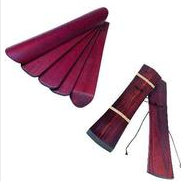tanban overview

Sandalwood(pinyin:tán bǎn), also known as clapper for short, is a traditional Chinese percussion instrument. The sound is made by knocking wooden boards against each other, usually composed of three pieces of wood or two pieces of bamboo, and the boards for various music and drama vary greatly. During the reign of Emperor Xuanzong of the Tang Dynasty, Huang Fanchuo, a musician in the pear orchard, was good at playing this board, so it is also called Chuoban.
The history of sandalwood can be pushed back to the Tang Dynasty at the earliest, and it may have been introduced from the northwest. It was used in folk music at that time, and in the murals of the Five Dynasties, it can be confirmed that it was used in palace music. Later, it was widely used in folk rap music, instrumental music, and opera accompaniment. Including rap "ban music", Yuan Dynasty Zaju, and Nanguan are used.
In the early Tang Dynasty frescoes in the Thousand Buddha Caves in Dunhuang, there are already painted figures of musicians striking sandalwood boards. In the frescoes of the Bohai Tomb Group (AD 698-926) in Jilin Province, there is also an image of a female musician holding a sandalwood board. Among the musical instruments of the Tang Dynasty, the musical instrument that controlled the rhythm and the beginning and the end was the Jiegu, and the singing was accompanied by the sandalwood. In the Tang Dynasty, sandalwood or mulberry was used to make sandalwood, and because the Tang Dynasty musician Huang Fanchuo was good at using this instrument, it was also called "Chuoban", which is the same as the old name of Chaoyue.
- Pinyin:tán bǎn
- nickname:clapboard, clapperboard
- category:percussion
- material:Made of mahogany, red sandalwood, rosewood or litmus, etc.
overview of other similar instruments
- sanyanxiao overview
- Daguangxian overview
- Leiqin overview
- hahao overview
- yandundagu overview
- Han Xiaozheng overview
- Fang Xiang overview
- guanzi overview
- zhuqin (Dao Qin) overview
- zhuiqin overview
- bangzi overview
- three-stringed piano overview
- Gehu overview
- xiao overview
- xiaokonghou overview
- Konghou overview
- Sheng overview
- suona overview
- hulusi overview
- gushao overview
 渝公网安备 50010702504639号
渝公网安备 50010702504639号